Alaska Fish & Wildlife News
March 2022
Women of Fish and Game
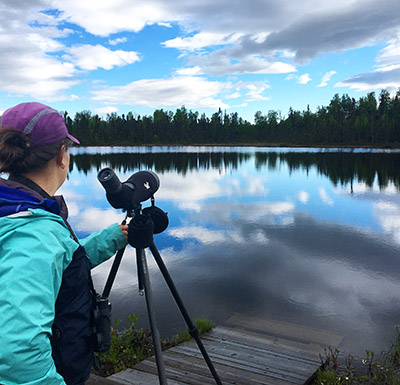
March is Women’s History month, and we are spotlighting women at the Alaska Department of Fish and Game who are working towards sustainable natural resources in Alaska.
Gender equality in science, technology, engineering, and math (STEM) has long been a topic of discussion. Though numbers are improving, women are still undervalued and underrepresented in STEM professions across the United States. Women are nearly half of the workforce in the U.S. but hold only 27% of the STEM positions. Women at the university level have also been shown to excel in academics, yet still be viewed as underperforming, and denied opportunities as a result of gender discrimination.
Additionally, further barriers and underrepresentation exist for minority groups in STEM professions, despite research that more diverse working groups are more productive and adept at problem solving.
This article came out of a grassroots effort within Fish and Game to showcase some of the amazing women scientists who work at ADF&G and to inspire more women and girls to pursue careers in STEM.
Lindsey Dreese
Wildlife biologist in the Wildlife Health and Disease Surveillance program, Fairbanks
I work with all species, large and small, across the state. Any day I get to spend in the field working with wildlife in Alaska is a good day and an opportunity to learn. I have many fond memories of the few short years I have been in wildlife, but a few particular ones come to mind. The first would have to be assisting with Forty-mile caribou captures. It was my first time in a helicopter and first capture experience. Anyone who has spent any time in Forty-mile country knows its beauty and it was truly special to experience it from the helicopter. Skating over rounded mountain tops lightly dusted in snow, it just doesn’t get much better than that. Of the seven caribou we handled that day, I specifically remember one young female who was very curious. As we took our requisite samples, she was keeping a gentle eye on us. I was up by her head working and as her and I made eye contact she reached her nose up and gave me a big caribou kiss. It just made me laugh and it’s not a memory I’m soon to forget.
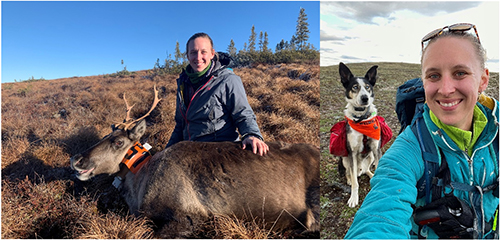
One of my other favorite field projects to assist with is the Koyukuk River Check station. While this project doesn’t involve working with live animals, I get to interact with hunters from all walks of life as they head upriver, most in pursuit of a moose. From issuing permits, to measuring the myriad of antlers from successful hunters, to enjoying a quiet day on the Koyukuk River, I love the work at check station. It’s fun to get to chat with all the hunters and hear their stories.
It might sound cliché to say, but nature and the natural world inspire me. There is always more to learn!
Jenell Larsen Tempel
Wildlife Biologist with the Threatened, Endangered, and Diversity Program, Juneau
I have had always had a great variety of career interests in biology- physiology, reproduction, ecology, and evolution. I thought I might study the cognitive abilities of captive marine mammals, or become a professor, or maybe a museum curator, but the one constant that really captured my love for biology was the water. Time spent on it, under it, in it or around it. A professor and mentor pointed this out to me as an undergraduate. From my sophomore through senior year, I volunteered on a bottlenose dolphin study on the St. Johns River in Jacksonville, Florida. I piloted the Boston Whaler we used as our survey vessel and conducted focal follows in kayaks on the weekends and after classes. “You know,” Dr. Borkowski said to me, “you seem happiest when you’re on the water and in the field. Have you ever considered becoming a wildlife biologist?” And she was right! Some of my favorite memories in college were Friday afternoons boating down the river, a pair of binoculars in hand scanning for grey dorsal fins cutting along banks, and a ball-cap shielding my face from the hot Florida sun.
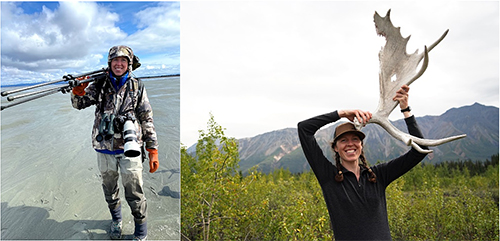
I went on to do several internships in college, fell in love with Alaska while studying Steller Sea Lions, and achieved my PhD in Fisheries at UAF a few years later. After graduate school I accepted a position with ADF&G as their Endangered Species Biologist. My favorite thing about my job is the diversity! I work on everything from belugas to bumblebees, but my current focus is on Red Knots, a robin-sized shorebird species that is in decline. I’m launching a study to determine the number of Red Knots that use Controller Bay as a spring stopover location.
My advice to women looking to become wildlife biologists is to be flexible and seek out opportunities. It turns out I’m just as excited to study birds and fish as I was to study marine mammals, so don’t be afraid to branch out or diverge from the path you thought you might take. Also put yourself out there. It’s a competitive field and sometimes there are opportunities that aren’t advertised. Introduce yourself to that amazing speaker from the plenary at a conference, show up at your professor’s office hours to ask about internships and job/volunteer opportunities, and don’t be afraid to pick up the phone and cold call a potential employer or mentor.
Stephanie Sell
Wildlife biologist, Juneau
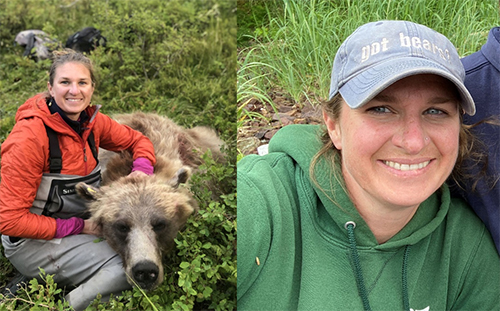
My name is Stephanie Sell and I’m a wildlife biologist currently conducting research to estimate the population and density abundance of brown bears in GMU 1D (northern Southeast Alaska, around Haines). I was born and raised in Anchorage but am now living in Juneau. I started working with ringed seals in the Arctic as an undergraduate at UAS and continued my research through to a master's degree in conservation biology at Central Michigan University. I started working at ADF&G in 2009 as Sanctuary Manager of Walrus Island State Game Sanctuary on Round Island in Bristol Bay. During the winter months I worked with our wildlife veterinarian conducting disease surveillance on moose in southcentral Alaska. I transitioned to southeast Alaska in 2012 after accepting the assistant area biologist position in the Douglas office. After two years I was promoted to area biologist and was in charge of managing all wildlife species in northern Southeast Alaska, before moving to research where I’m now working with brown bears.
I knew I wanted to be a biologist from a very young age being inspired by elementary school teachers, like my mom, who promoted educational science programs like “Voyage of the Mimi” and brought me along on her outdoor school field trips to places like Seward and Homer as a kindergartener. I was fortunate growing up to have parents that exposed me and my siblings to the outdoors through travel, camping, exploring, and fishing at our cabin on the Kenai. There are too many fond memories working with wildlife to list here. I’ve been lucky in my career to have worked with several species of wildlife but I am constantly amazed by all the beautiful and rural places they have taken me throughout Alaska. As a woman working in a male dominated field, I feel very fortunate to have had all these opportunities and hope to inspire the younger generation of women. Follow your dreams.
Kristen Gruenthal
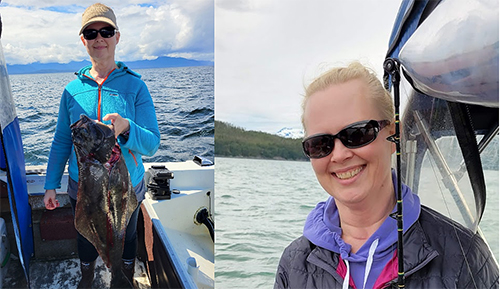
Fisheries Geneticist, Juneau
I always wanted to have a positive impact on declining, threatened, and endangered species. I left human disease genetics (a long time ago now) to get my PhD working in conservation genetics. Since then, I’ve been very fortunate to continue working on a number of economically and socially important aquatic species in the wild and in aquaculture. After postdocs and jobs along the West Coast and in the Midwest, our family moved to Juneau. I was lucky that the ADF&G Gene Conservation Laboratory opened a position that seemed a perfect fit, focusing on hatchery-wild impacts in pink and chum salmon in particular, and mariculture research in general. Alaska is one of, if not the only, state in the United States that has a genetic policy designed to “protect the integrity of important wild stocks.” So, it’s not only gratifying to be able to stay in the field that I chose, but to work for a state that has such an abundance of fish and wildlife, with a mission to sustain those populations, while supporting myriad user groups.
It might sound cheesy, but my kids’ fascination with this place (Juneau and Alaska) inspires me. My son sees everything around him with excitement…looking for mining treasures at Sandy Beach, fishing for halibut in Icy Strait (with his special cut bait, of course) or pinks in Echo Cove, or making “ships” out driftwood on any shoreline. My daughter loves listening to and watching the Stellar sea lions at their haul outs and stalking marmots at St. Therese. I want to help keep this place special for them.
Tory Rhoads
Wildlife biologist, Threatened, Endangered, and Diversity Program, Juneau
I work mostly with bats and other research projects in Southeast Alaska, currently studying the efficiency of scent detection dogs in locating bat hibernation sites.
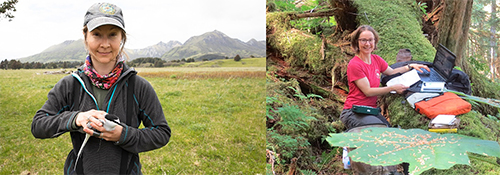
One of my favorite memories working with wildlife was from 2017. It was the pilot year of the Aleutian Tern project, in collaboration with researchers from the USFS and Oregon State University. After some initially frustrating efforts, we were able to capture birds by broadcasting Aleutian Tern calls and planting Aleutian Tern decoys near bow-nets, which we remotely deployed from a nearby dog blind. We deployed small satellite tags on a handful of birds; the tags offloaded location data, which we could then download to get daily updates on their movements. Subsequently mapping out their migration route from Yakutat and Dillingham to Russia, China, and, eventually, to Indonesia, it was absolutely incredible!
Julie Hagelin
Wildlife biologist, Threatened, Endangered, and Diversity Program, Fairbanks
I’m based in interior Alaska and my research focuses on reducing the steep decline of the Olive-sided Flycatcher, an internationally recognized species of conservation concern.
I’ve had many incredible experiences working with wildlife, once I banded a baby Tree Swallow at Creamer’s Field in Fairbanks and a year later held that same bird in my hand as an adult female. The second time ‘round, she had her own brood of chicks. What stories I wanted to hear of her travel adventures! Thanks to collaborative work of the Alaska Songbird Institute, we now know that Fairbanks Tree Swallows migrate through the Midwest (south, along the Mississippi), and overwinter around the Gulf of Mexico. This information helps biologists manage important habitat at key places along the way, so birds like that female can make it back home to breed.
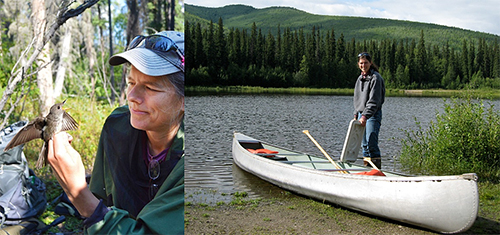
Even though biologists estimate that North America has lost a staggering three Billion birds (with a “B”) since I was a baby, there are 7 Simple Steps each of us can take that will collectively make a difference to reduce future bird losses. One easy step I take is buying “Bird Friendly” certified coffee , which Smithsonian scientists have shown promotes forest habitats and insect foods that our migratory birds need to survive, instead of destroying them. This can help many species have a better chance of returning north to breed, including some in our own backyards!
Tessa Hasbrouck
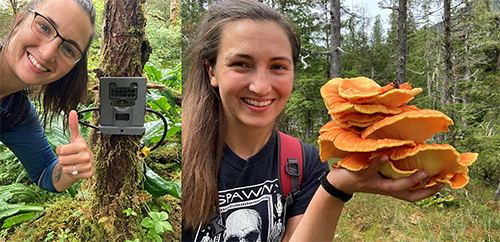
Wildlife biologist, Ketchikan
Almost three years ago, I moved to Ketchikan to be a wildlife management biologist for the Alaska Department of Fish and Game. This was (and is) my dream position, located in a dream region of the state.
I was born in southeast Alaska and raised by my commercial fishing family. Wild places, wild life, and wild foods began inspiring me at a young age. I am so pleased to have returned to southeast for this position. My job duties ebb and flow with the changing seasons, which seems to make time stream by quickly. Summer is for helping with bear calls, installing trail cameras for deer, and collaring wolves. Fall is for collecting wolf genetics, surveying mountain goats, and sealing harvested goats and bears. Winter is for writing reports, catching injured eagles, and investigating collared wolves. Spring is for advising excited hunters, listening for grouse, and prepping for the summer frenzy. Each new season is met with a flush of enthusiasm and excitement for a change in pace and in scenery.
Since I am in my dream position, in my dream location, I had expected to feel relentlessly inspired. Perhaps that expectation is a bit unrealistic in normal times, but it’s pert near impractical during these series of “unprecedented” times. I’m writing this during a time when my community has essentially decided that the pandemic no longer exists, even though we just had our 21st Ketchikanite pass away from Covid-19. Additionally, I’m writing the day after Russia invaded Ukraine. Yesterday, as Russia made its first moves to cross the border, my helicopter pilot and I meandered around a sunny patch of muskeg searching for wolf scats. In the past few years, it has sometimes been hard to feel like my day-to-day tasks are important, while life-altering events are happening all around us. It’s felt surreal. I’d hazard a guess that I’m not alone in this. However, that line of thought is faulty. Each wolf scat I pick up, each figure I create, each phone call I answer, helps aid in conserving the wild places, wild lives, and wild foods that inspire me. They’re all little pieces of the delicious conservation pie. These tasks we do as biologists are important, as are we.
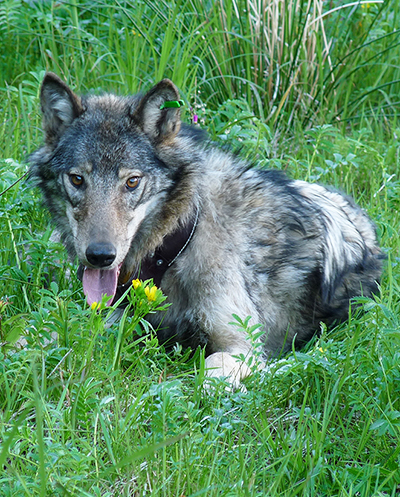
So, friends, I’d like to ask that you continue to be kind, take your vitamin D, and know that spring is coming (the 2” tall chives in my garden say-so).
Joelle Hepler
Wildlife Biologist, Glennallen, AK
I am the Assistant Area Wildlife Biologist in the Glennallen area and I help manage our wildlife populations in Game Management Units 13 and 11.
I grew up in the Pacific Northwest and moved to Fairbanks in 2017 to complete my Master’s degree in wildlife. It was then that I truly got exposed to the vastness of Alaska through flying caribou surveys on the northern coast of the Arctic National Wildlife Refuge. Since then, I have always had a soft spot for caribou and their amazing ability to effortlessly run across the tundra with all of its obstacles. My best memory so far in my wildlife career has since been capturing and collaring 4-month-old caribou. During these captures we have one person sit with the calf and wait for them to fully come back from the capture drugs and get up to re-join the cow. In these few quiet moments, it’s just you, a small calf with fuzzy lips, and the solitude of remote Alaskan wilderness. Sometimes the calf is a little confused when they get their feet under them, and they come right up to you thinking you might be their mama, but they usually figure things out pretty quickly and take off to join back up with their group. It’s truly an incredible feeling to be able to interact with these animals up-close and just take a moment to appreciate how awesome caribou are and how beautiful their habitat is!
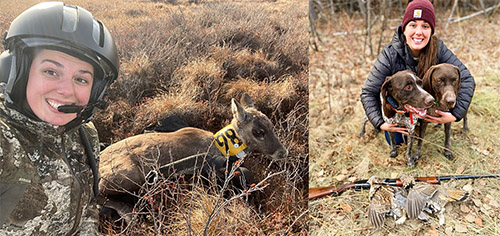
From a young age I had two loves in life: the great outdoors and animals. My parents fostered this love by taking me and my sisters on camping trips, hunting trips, the zoo, museums with special animal exhibits, and just inspiring a general sense of wonderment and desire to learn more about the world around us. When my passion for wildlife biology really started to take hold, I had four accomplished older sisters, a strong-willed mother, and some amazing female biologist friends, to show me that even in a male-dominated field, if you put in the work for what you love, you can achieve anything. The more women I see taking hold in this career field the more inspired I am to continue to research, outreach, and educate our youth to spark that wildlife flame in another young woman’s heart.
Katie Christie
Wildlife biologist, shorebirds and small mammals, Anchorage
My passion for wildlife biology was sparked by a diminutive bird weighing about as much as 3 paperclips. I was on the pre-med track at the University of Victoria, Canada but quickly tired of the smell of formaldehyde and endless dissections of dead cats. I began to resent putting on my white lab coat and longed to get outside. At the same time, my ecology and evolution classes were introducing me to enthralling topics such as natural selection, mimicry, and predator-prey dynamics.
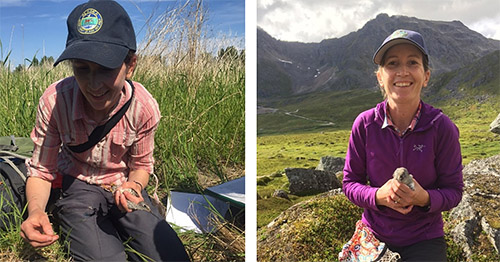
After receiving practical advice to gain some field experience, I decided to volunteer on a citizen science project studying Anna’s Hummingbirds, a tiny green bird with a brilliant pink throat and a penchant for visiting feeders around Victoria. I went out in the early dawn hours to trap and band these tiny but vigorous birds, with the hopes of gleaning information on their survival and movements. The feeling of awe when I held my first hummingbird fueled my journey towards studying and conserving the small, but important animals that we often take for granted.
Here in Alaska, I spend my time uncovering the mystery of why a once common boreal shorebird (the Lesser Yellowlegs) has declined so rapidly over the past few decades, and how to reverse these declines. I also oversee a research project investigating collared pika populations in the mountains of southcentral Alaska, bettering our understanding of how this intrepid lagomorph will respond to warming temperatures and altered alpine vegetation. I feel extremely lucky to have had incredible opportunities and mentors that made it possible to become a wildlife biologist and want to support people who may not otherwise have the chance to pursue this exciting and rewarding career path.
Find more spotlights on ADF&G’s social media this month.
Alaska Department of Fish and Game
Threatened, Endangered, and Diversity Program
Subscribe to be notified about new issues
Receive a monthly notice about new issues and articles.
